When we say “atom,” different people get different mental images. Those that grew up on the Knowledge Channel and/or were avid readers of their science textbooks would have the image of a nucleus with electrons revolving around it in circular orbits. Those that grew up during the Cold War would be reminded of the nuclear arms race. Fans of superhero movies would name different superheroes who got their powers due to radioactivity or an accident at a nuclear facility. The truth, however, is quite different.

Figure 1. How most people think an atom looks like.
An atom is the basic unit of an element. Basic here refers to the fact that when an element could be broken down into its tiniest recognizable piece, that piece would be an atom. In the centre of the atom is the nucleus, composed of two particles: the neutral neutron, and the positively-charged proton. Outside the nucleus are the negatively-charged electrons which “revolve” around the nucleus. Simple, right? Well, not really.
The early study of the physical properties of elemental atoms is called Atomic Physics. Prior to the works of Thomson (discovery of the electron), Rutherford (discovery of the nucleus and, by extension, the proton), Chadwick (discovery of the neutron), Bohr (the proposal of the “planetary model” of the atom), and their many colleagues, scientists thought that the atom was the most basic unit of any substance—that it is indivisible. We now know that sub-atomic particles, particles that are smaller than an atom, exist. We now know that there are particles even smaller than sub-atomic particles. Getting to that knowledge, however, was a process which spanned over 50 years.

Figure 2. How an atom would actually look like.
Getting to that knowledge was a process which spanned over 50 years.
It first started with radioactivity. In 1896, French physicist Antoine Henri Becquerel observed that certain Uranium salts emitted a certain “phosphorescence,” emitting a light that could penetrate opaque materials. At first, he thought that it was a manifestation of a new type of X-Ray, as Wilhelm Röntgen (the discoverer of X-Rays) had published his groundbreaking discovery just a few years prior. However, upon further experimentation, it was determined that the “phosphorescence” was a different kind of phenomenon “powered” or “triggered” by a different mechanism. After Becquerel published his findings, Marie Curie and her husband Pierre Curie conducted groundbreaking research on radioactivity. They isolated and characterized two elements which exhibited the properties Becquerel had published before: Polonium and Radium. Marie Curie coined the term “radioactivity” and made significant contributions to the field. Their findings prompted physicists all over the world to follow in their footsteps. By the 1900s, three types of radiation had been discovered: alpha, beta, and gamma. Becquerel, Marie, and Pierre Curie were awarded the Nobel Prize in 1903 for pioneering the study of radioactivity.
Around the same time, J.J. Thomson and his colleagues were experimenting with cathode-ray tubes, leading to the discovery of the electron. While this finding was more relevant to other fields, such as Electromagnetism and Quantum Mechanics, it influenced the paradigm towards the study of the atom. Thomson’s findings demonstrated that atoms were not indivisible as previously believed but were composed of smaller “sub-atomic” particles. Through his findings, Thomson proposed that the atom was a “cloud” of positive charge and that the electrons floated inside said cloud. This model was named the “Plum-Pudding Model,” as the raisins distributed inside a plum-pudding cake are like the electrons suspended inside the positively-charged “cloud.”

Figure 3. A representation of the “Plum-Pudding Model” as proposed by Thomson.
Around 1904, Japanese scientist Hantaro Nagaoka proposed a “planetary” model of the atom to oppose J.J. Thomson’s “Plum-Pudding Model” of the atom. Nagaoka countered this by saying that opposite charges can’t “penetrate” each other. An electron inside a “cloud” of positive charge would be overpowered by the cloud, thus losing its negative charge. He proposed that there is a positively charged “core” to the atom, and the electrons revolved around it the same way the rings of Saturn revolved around the said planet. Instead of gravity keeping the rings intact, it was electromagnetic interactions between the electrons and the positive nucleus which bound the electrons to their orbits.
However, Nagaoka’s rather simplistic model still had problems. On the scale and size of the atom, electrons would be repulsed by the positively-charged nucleus simply because of how close they are. After a while, even Nagaoka gave up on this idea.
Ernest Rutherford, from 1908 to 1913, directed multiple experiments done by Hans Geiger and Ernest Marsden in which they tested the validity of J.J. Thomson’s “Plum Pudding Model” of the atom. They hypothesized that if a “non-solid” cloud of positive charge really was the structure of the atom, then an alpha particle could pass through said cloud and not be deflected. In the 5-year period, they conducted the famous gold foil experiment, where they bombarded gold atoms with alpha particles, and found that the passing alpha particles were scattered radially and did not simply pass through. Based on the observed scattering patterns, Rutherford proposed the nuclear model of the atom. He suggested that atoms had a tiny, positively charged nucleus at the centre, with negatively charged electrons orbiting around it.
It was only after Rutherford’s discovery of the nucleus was Nagaoka’s proposed model partially vindicated.
In 1913, Niels Bohr, building upon the work of Rutherford and pioneering the newly discovered field of Quantum Mechanics, proposed a similar “planetary” model which did not have the problems of Nagaoka’s. Bohr’s model, however, only works for the lighter atoms and does not correctly model the structures of larger and heavier atoms. Its simplistic nature, as well as the fact that it is partially correct, made it a staple representation of how an atom “looks like.”

Figure 4. Bohr’s “Planetary Model” of an atom.
James Chadwick discovered the neutron in 1932. This finding completed the picture of atomic structure, explaining the stability of atomic nuclei despite their positive charge. Think of it this way: Imagine that you have two strong magnets. If you forcefully push the positive sides of each magnet to stick together, you can feel a very strong force that would like to separate them. The same goes on inside the atom. Since the protons are so densely packed together inside the nucleus, they are pushing each other off with very great force. Having neutrons in between said protons lessens the repulsion between the protons and thus makes for a stable nucleus. That is why heavier elements, such as Uranium and Plutonium, have a lot of neutrons in their nucleus—often outnumbering the protons.
In December 1938, Otto Hahn, Lise Meitner, and Fritz Strassmann demonstrated the phenomenon of nuclear fission. They split the nucleus of uranium into smaller fragments using neutron bombardment, releasing a significant amount of energy in the process.
Fearing that the Nazis, having access to most of the experts in Nuclear Physics, would use nuclear fission to develop an atomic weapon, the American government laid plans for a secret weapons development project. Led by J. Robert Oppenheimer, the Manhattan Project brought together many prominent scientists, including Enrico Fermi, Niels Bohr, and many others who had fled from the Nazi Blitzkrieg, to develop an “atom bomb” before the Germans could. Their combined efforts accelerated research in nuclear physics, leading to the creation of the first nuclear bomb. After the war, however, many of the scientists directly or indirectly involved with the project took a stand against the use of such destructive weapons. Instead, they pioneered fields which are now the foundations of modern nuclear energy, as well as other fields such as in medicine, research, and even communications.
These milestones, along with subsequent advancements and discoveries, propelled the study of nuclear physics forward, leading to a deeper understanding of the structure and behaviour of atomic nuclei, as well as the development of various applications in energy production, medicine, and scientific research.









